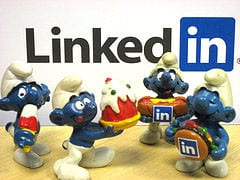LinkedIn is typically used for networking among employees, but companies–especially online ones that customers may never interact with face-to-face– are finding that having a LinkedIn presence can help validate their reputation for consumers by establishing credibility and trust. There are over 1.9 million companies with profiles on LinkedIn, and these companies have 100 million professionals following them to get updates, learn of job openings and have advance notice of new products and services.
LinkedIn offers a company page that allows you to centralize business information, controlling the publicly accessible LinkedIn profile for your business. Think of it like a central hub for professional information, with your employees’ personal pages representing spokes of the hub that offer greater insight into your goods and services. There’s a lot to be gained from developing a company page. You can access analytics data that shows what LinkedIn connections are looking at, and how they’re accessing it. Promote your goods and services by showcasing products, campaigns and graphics, and send private message to those in your circle to inform, entertain and connect.
Why Is LinkedIn A Good Resource?
Because this information comes from a professional networking service, members view it more positively than something like a Facebook post. Users perceive LinkedIn information as somehow more authoritative because it’s posted on a networking site with a veneer of professionalism, and not on a social media site, where the same information could be construed as marketing or promoting. Additionally, colleagues and connections can write recommendations for you that appear on the company page, showcasing more authority and inspiring more confidence in you than Facebook posts on your Wall. You can pull in an RSS feed from your company blog and a Twitter feed, but here these modules seem more newsy and less social.
Making A Successful LinkedIn Page
An example of a company with a nice profile page is YouSendIt, a tech company that offers document sending and storage via the Internet. The company’s LinkedIn page begins with an overview to introduce the company and its services to people who come across it. LinkedIn automatically pulls in newsy features from other sites, such as TechCrunch, that can help put the user at ease by offering authoritative third-party information about the company in question. Map data shows the street address, and other general information on the company size, type and founding date provide the basic information users need and want to know that can often be buried on the company’s website or missing from social media. The products tab showcases products–in this case, applications and product trials–that can then be recommended by regular LinkedIn users. The Careers tab showcases available job openings, connecting users to positions that may interest them and offering quotes from existing employees on why they’ve chosen YouSendIt. An Insights tab provides analytics data to the company’s administrators, allowing them to see what parts of the company page have been accessed. This provides administrators with real-time data that can be used to improve page functionality.
Additional benefits of creating a company page include higher search engine results, since the page is indexed by search engines and full of SEO-rich data, and access to LinkedIn data of potential new hires. Make smarter decisions about business and hiring, and provide customers with information, authoritative information through LinkedIn.
The Power of LinkedIn Pages! | Chappaqua NY Homes
Leave a reply
via dreamgrow.com

